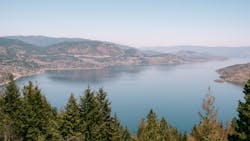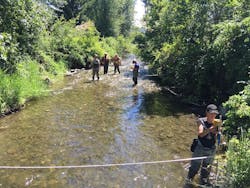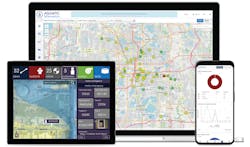About the author:
Chris Heyer is senior director of sales for Aquatic Informatics. Heyer can be reached at [email protected].
The Okanagan Water Basin is deemed a region of interest by the federal government as it straddles the Canada-U.S. border, and is marveled by hydrologists as a living laboratory that includes one of two deserts in Canada. It also has one of the highest numbers of species at risk.
Due to eutrophication of mainstem lakes in the mid-60s, the Canadian government conducted the Okanagan Basin study (1974), one of the largest federally-funded limnology (freshwater science) studies ever conducted in Canada. Being a relatively small area of 8,200 kilometers, the Okanagan watershed supports residents, agriculture, forestry, fisheries, and tourism resulting in the need for many special interest groups to work together to protect and preserve the flow of clean water through this unique valley.
In the 1960s, Okanagan Basin had water pollution problems from poorly treated sewage effluent, runoff from cattle yards, and organo-phosphate/lead-arsenate insecticides that created algae blooms and toxic conditions in Okanagan Lake. This also led to the establishment of the Okanagan Basin Water Board (OBWB) in 1970, which is a valley-wide partnership between the three regional local governments to identify and resolve critical water issues in the Okanagan watershed. One of the earliest programs of the OBWB was its sewage facility grant program, supporting local governments to upgrade areas on septic to community sewer, and purchase state-of-the art wastewater treatment facilities. Municipalities stepped up to the plate and upgraded their wastewater treatment plants at an impressive pace. Within 20 years, the level of phosphates in the lake dropped by more than 90%.
The federal government expanded water monitoring in the basin to include 160 hydrometric stations. These stations were installed, in part, to address the 1974 Okanagan Basin Study recommendations and anticipated increased local water demands. Today, however, there are only 23 Environment Canada-operated hydrometric stations left in the watershed and OBWB is working with partners to bring that number back up as climate change is impacting the area.
“Prior to the mid-1980s we had great hydrometric data from Environment Canada, including some stations that had over 60 years of data,” said Nelson Jatel, OBWB’s water stewardship director. “Due to funding cuts, the number of hydrometric stations left operating throughout the region dropped significantly. At the same time, we have seen rapid population growth and evidence of a changing climate. Unfortunately, the reduction in critical hydrometric data has reduced important information for water management that could have benefited fisheries, forestry, agricultural, and flood/drought infrastructure. The sooner we can get more data on the long-term trends of systems, the better equipped we are to deal with climate change and long-term management of our water system.”
In 2021 the OBWB started a hydrology monitoring program to fill in the gaps.
Optimizing Data for Sharing Actionable Insights
In 2021 OBWB implemented a new hydrometric program (obwb.ca/hydromet) with a mandate to work with partners and establish new hydrometric stations that would, in part, support the development of environmental flow data, and support new hydrology models. To manage this data OBWB uses Aquarius software to acquire, process, model and publish water information in real time.
“I refer to Aquarius as the ‘Microsoft of hydrometric data,’” Jatel said. “It is used by Environment Canada, USGS and other water monitoring agencies, so data sharing and integration are seamless.”
OBWB has data coming in from partner agencies and publicly available sources, and they also collect their own Class 2 data, the highest quality data not collected by Environment and Climate Change government staff. Aquarius enables OBWB to centralize this vast amount of hydrologic time series data, discrete measurement data, and complex river gauging measurements from various locations. From the platform, OBWB can correct and quality control the data, build rating curves, derive statistics, and report in real-time to share insights with stakeholders.
“Sharing data from Aquarius gives our data a QA/QC stamp of credibility that allows smaller organizations like us to punch above our weight when it comes to delivering reliable and trustworthy data with the big players like Environment Canada,” Jatel said.
Climate Change Increased the Value of Data
Hydrometric data is vital to managing and protecting the use, flow and quality of water, and dealing with the impacts of climate change that is affecting the whole planet. Consequently, the need for reliable data has never been stronger.
“Fifteen years ago, the value of water data was said to be a $19 return on every dollar invested. Today, I think it is significantly more valuable,” Jatel said. “With modern data management tools, like Aquarius, we can leverage the dollars spent by easily sharing information with water partners across the country through cloud-based internet tools.”
While predictive modeling in the Okanagan Basin indicates the net water input into the basin is not expected to change by 2050, the model indicates there is an ongoing and significant shift of the hydrograph — representing earlier freshets — based on data trends from the past 50 years. As well as earlier freshets, more of the precipitation will come as rain, rather than snow. This modeling, largely based on hydrometric data, affects decisions on infrastructure, crop selection, water storage and policy. For example, a longer dry period during the early fall will increase demand for agricultural irrigation at a critical time when the Columbia River Sockeye and Chinook salmon need water to travel upriver to spawn. It is vital that water managers, First Nations, fisheries advocates, and agricultural producers come together to brainstorm and plan different management options to reduce future conflicts.
Partnerships are Vital to Small Watersheds
OBWB’s motto, “One Valley, One Water” has led to dozens of partnerships, monthly meetings with the Okanagan Water Stewardship Council, and the formation of several council committees representing multiple interests on various water subjects. Within the new Okanagan hydrometric service program, one of these partners is the Okanagan Nation Alliance (ONA), which includes seven First Nations bands, of which four are in the Okanagan Basin. ONA has a fisheries department that has been working hard to restore salmon stocks in the region. With millions of dollars in funding from U.S. Hydroelectric production, they have built and manage a salmon hatchery in Penticton where 5 million salmon fry have been reared and released every spring since 2014 (www.syilx.org/fisheries/hatchery/). Environmental flow data is vital for ONA to ensure the successful release and return of the salmon in the Columbia River system.
“Over the past two decades I have had the pleasure of working with the Okanagan Nation Alliance Fishery staff,” Jatel said. “During this time, I have heard elders consistently message that bringing back the salmon to Okanagan valley-bottom lakes is imperative. Several of our new hydrometric stations, managed in partnership with ONA Fishery staff, are prioritized to support the heavy lifting that is being done by the ONA. The ONA Fishery team is an outstanding partner in the collection and management of hydrometric data, and they have led the restoration and preservation of the Okanagan’s salmon fish habitat and ecosystem. It has been a privilege to work with such an outstanding team of water professionals. And there is a lot more work that needs to be done.”
Hydrometric Data Reduces Flooding Impacts
The shift in the Okanagan’s hydrograph also means more rain in the snowmelt season which will dramatically enhance the vulnerability window for flooding. With reliable data, OBWB is expanding the mapping of floodplains to include flood hazard mapping and shares this information through its Okanagan Flood Story website and flood portal, as well as social media channels. Using historic and current data, stakeholders have access to knowledge that can play a role in zoning, planning for infrastructure, or helping residents choose where to build or buy a house. It also gives residents strategies to reduce the risks of flooding and tips for floodproofing.
Public Outreach Builds Individual Water Stewards
The Okanagan has the lowest per-person water availability in Canada, so public engagement is critical. OBWB’s outreach and education program, Okanagan WaterWise, is intended to help the public understand where their water comes from, why water conservation and protection is important, and how to do this – in the home, in the yard, in business, in schools, and in the community. Between May and October, it runs an annual valley-wide water conservation campaign, “Make Water Work,” aimed at tackling the 2nd largest use of all water in the valley – outdoor residential use. Among its many resources, Okanagan WaterWise has also developed curriculum materials now available to, and being used in, Okanagan schools. It is also active on social media and YouTube to keep the community engaged.
Ensuring all stakeholders have up-to-date, relevant information allows communities to plan for the future and respond to problems with water systems. Another program that OBWB has initiated is the BC Water Use Reporting Centre.
“This started as a local initiative to get municipalities to record water usage monthly rather than annually, but we soon realized this tool would be valuable to all water managers and has been voluntarily adopted in several communities throughout the province,” Jatel said. “The increase to monthly usage reporting has made a meaningful impact on the granularity of data, reporting monthly instead of annual use data, and is enabling participating B.C. water license holders to monitor water-use patterns so they can modify consumption and fix aging infrastructure before it becomes critical.”
An online portal makes it easy for participants to access and input their data, and it streamlines management for the province with automated processing and secure storage of data in one platform. This voluntary water use reporting software also adds a level of transparency to water consumption that can motivate better practices.
The Okanagan Water Stewardship Council’s most recent Sustainable Water Strategy: Action Plan 2.0 includes 50 actions designed to protect water at its source, plan for flooding and drought, manage water demand, collect and share data, and to collaborate and build partnerships. This collaboratively developed, modern, comprehensive strategy is intended to safeguard the Okanagan Water Basin and is an outstanding model for all watershed monitoring agencies.
“Hydrometric data is at the heart of water management,” Jatel said. “Collecting, managing, and making this data transparent are all important steps to ensure the data may be used to support actionable insights into our changing water patterns for our partners and programs, and is an important OBWB service. As many watersheds throughout the world struggle with the impacts of climate change, water shortages, and emerging contaminants of concern, it is essential that governments and partners collaborate to improve our relationship with water. By gathering high quality hydrometric data and sharing insights resulting from data-dependent hydrology models, we can find practical solutions to protect our water, and the social-ecological systems that depend on it.”


